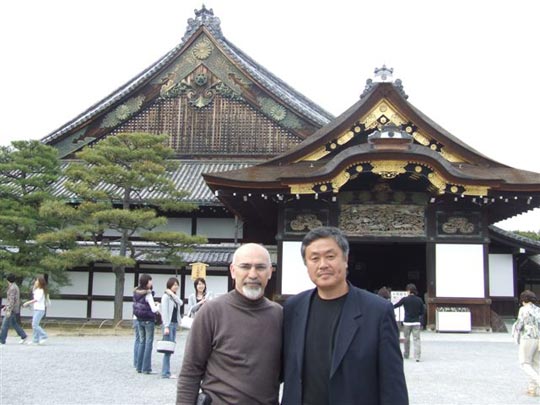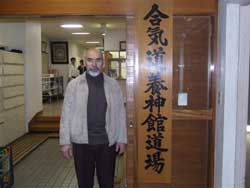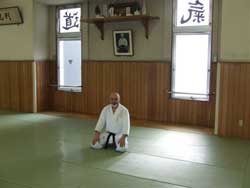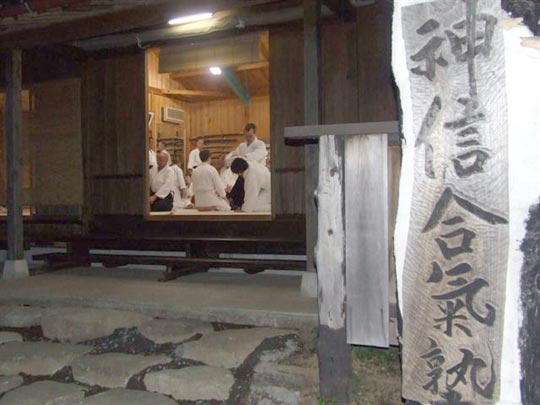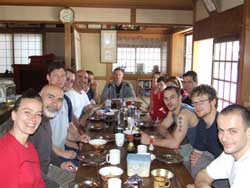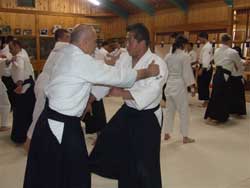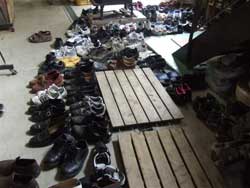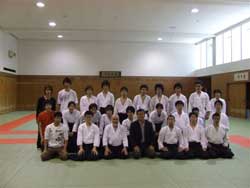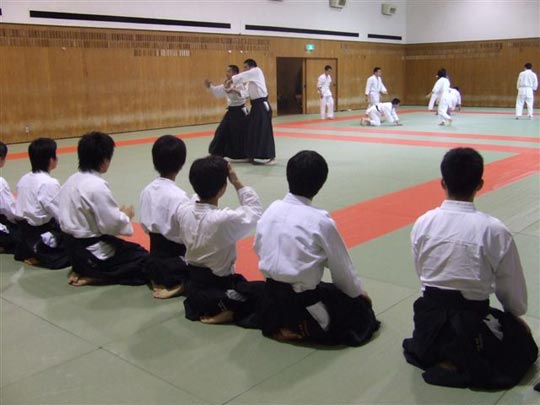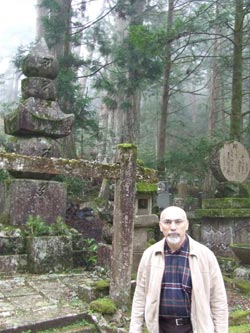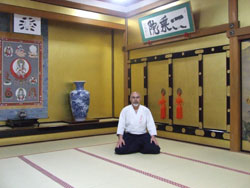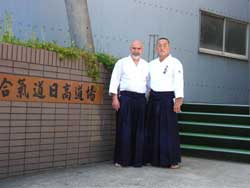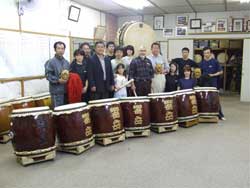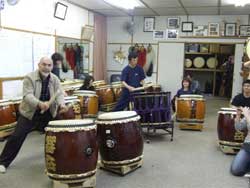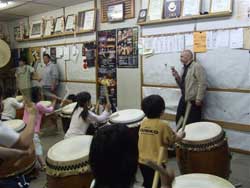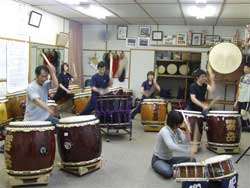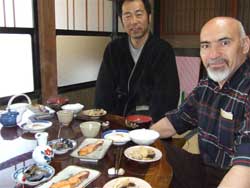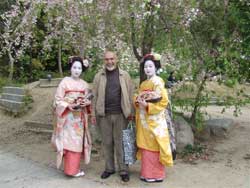April 24th-May 5th, 2006
Written by Gaku Homma
Nippon Kan Kancho
ARRIVAL AT NARITA AIRPORT TOKYO, JAPAN
I thought that Ali Sensei might have a little trouble with immigration so I was not surprised when he was delayed. I started getting concerned however after an hour had passed, everyone else had gone and even the baggage carousel had stopped. Finally I went to an immigration officer to enquire about Ali Sensei’s whereabouts. The officer asked me what my relationship was with Mr. Uludag, took MY passport and disappeared into the immigration office.
I waited for another hour. Finally Ali Sensei appeared under the escort of another immigration officer with a big smile on his face. As it turned out, there were not any problems with Ali Sensei’s papers or passport; the problem had been the contact address I had given Ali Sensei for his entrance paperwork. I had written down the contact information for my relatives in Japan but had forgotten to let them know. When the immigration officers called to verify Ali Sensei’s information, my relatives told the officers they had never heard of a Mr. Uludag! That of course caused a bit of a problem! The immigration officer apologized for the delay, referring to the state of security concerns “even in Japan these days”. Off to an interesting start, this was Ali Sensei’s first introduction to Japan.
VISIT TO AIKIKAI HOMBU DOJO FOR MORNING PRACTICE.
Most visitors wake up very early when they first arrive in Japan from the United States due to jet lag and time changes. Since we were both up early, it was a good opportunity to go to Aikikai Hombu dojo for morning practice. The office attendant listened as I introduced Ali Sensei to them and asked permission for him to practice. The attendant’s response to my introduction was only to ask for the fees owed to attend the practice. As the International Headquarter of Aikikai, I would think it would be important to be cordial to visitors. Possibly (if thinking positively) they just have so many visitors that they have become a little weary.
Today, there are more Aikidoists that practice in countries outside of Japan than practice in Japan itself. I would hope that customer service and hospitality would be a priority; especially with guest Aikidoka who have traveled so far and made such an effort to be there.
Ali Sensei enjoyed morning practice under Doshu’s direction, which I would think for him and the other travelers there would be a dream come true.
VISIT TO AIKIDO YOSHINKAN AFTERNOON PRACTICE.
- In the entrance of Yoshinkan dojo.
- In the dojo after practice.
The office attendant was very nice as he returned the greeting, “Thank you very much for taking the time to come. Please wait here a moment.” After leaving us for a moment, he returned and replied, “Inoue Kancho is currently out of the dojo, but you have come so far to visit, you are welcome to join in a special training clinic we are conducting right now if that is all right with you.” With that, we were escorted inside where Ali Sensei went to change for practice.“My name is Gaku Homma, and I am from America Nippon Kan. I have come today with an Aikido instructor from Istanbul, Turkey. We would like permission to experience practice at your dojo.”
Checking in at Yoshinkan dojo followed the same protocol as at Hombu dojo the previous day, but there was a big difference in the reception we received. At the Yoshinkan dojo, the staff and students had a very positive and healthy demeanor and were quick to make us feel welcome and appreciated. I could tell by watching Ali Sensei that he was impressed with the manners and attitudes of these young students. For the instructors to allow us to attend the special clinic they had scheduled was greatly appreciated. It showed flexibility and a sense of hospitality that had been lacking the day before.
I have visited this Yoshinkan dojo on previous occasions and the prevailing spirit here reminds me of the old dojo at Aikikai Hombu when the Founder Ueshiba was still alive. I was very appreciative of this.
VISITING IWAMA
From Tokyo we traveled by train to Iwama to visit traditional Iwama style, Shin Shin Aiki Shuren Kai and Hitohiro Saito Sensei. As usual we found him busy with a new project. Saito Sensei and his uchideshi were putting new rock steps into place in front of the dojo and it was quite the sight! The heavy equipment was working at a roar as Saito Sensei helped students move the large rock stepping stones into place. Ali Sensei and I just tried to keep out of the way as we watched the walkway unfold. Saito Sensei was very skillful in arranging the rocks, utilizing the equipment and directing the uchideshi together to achieve their goal. This skill he inherited from his father, the late Morihiro Saito Shihan, who had built many gardens all over Iwama. I thought of a different time in a different garden, when Morihiro Saito Shihan helped to lay the rocks in Nippon Kan General Headquarter’s gardens in Denver. While he was in Denver to teach I remember him saying “I cannot return to Japan until I have helped fix this garden of yours. I will stay until this is done.”
- Leading by example; Hitohiro Saito Sensei.
- Ali sensei with Tanren Juku uchideshi.
Finally Hitohiro Sensei smiled to us and greeted us like old friends. Saito Sensei and I had lunch together while Ali San Sensei went off to experience life in Iwama with the
Tanren Juku uchideshi. We both felt that it would be a good experience for Ali San Sensei to see what life was like as an uchideshi in Saito Sensei’s dojo. Ali Sensei participated in mealtime, clean-up chores and laid out his own futon (Japanese bedding) for later that evening. He seemed to enjoy his “mini uchideshi” experience with the other twenty or so uchideshi who had traveled to Iwama as well from all over the world. Ali Sensei was the oldest by far but had a good time as an uchideshi in Iwama.
Practice that evening was crowded, and the senior Iwama sempai made sure that Ali Sensei got a good “work out”. This was their Iwama style welcome, and it was a “hearty” one. I was a little concerned for Ali Sensei, but reminded myself that sometime practice experiences in Iwama are not always so sweet!
After practice I thought it might be a good idea to make stew for all of the uchideshi, so Ali Sensei and I went to the market to buy groceries. As a Turkish gentleman, this was his first experience shopping in a Japanese country market. He seemed to be enjoying himself as he pushed the shopping cart up and down the aisles with a big smile!
Ali Sensei (and I) cooking dinner for the uchideshi.
Before the festival began, we ran into an interesting situation that I have described in detail in my new article “A Dangerous Message”.The Aiki Tai Sai festival was held in Iwama the following day. We arose early, Ali Sensei looking quite smart in a crisp suit and tie. I am sure Ali Sensei had read about the Aiki Tai Sai Festival but this was his first experience being there in person.
The festival followed traditional protocol and was well attended. After the Tai Sai Ceremony, we returned to Shin Shin Aiki Shuren Kai dojo to attend a memorial reception for the late Morihiro Saito Shihan. The guest reception area above the dojo was packed with guests who attended the Shinto ceremony honoring the life of Morihiro Saito. After the ceremony a bountiful feast began. Watching Hitohiro Saito Sensei directing traffic, ordering uchideshi and making sure the guests were well taken care of, I again thought of his father, and the qualities of the father that had been inherited by the son. I could hear his father’s voice in his manner and in his tone. It reminded me of the years in Iwama not so long ago.
Ali San fit right in with the celebration, experiencing everything with an open mind and an eagerness to participate. At least here at Shin Shin Aiki Shuren Kai dojo, the spirit of Morihiro Saito still lives as part of the dojo color. The spirit of generosity and hospitality that was Morihiro Saito Shihan he taught well to the next generation. I thought as I watched the celebration; this is part of his legacy.
- So many people attended the memorial ceremony for Morihiro Saito Shihan.
- Ali Sensei enjoying the celebration.
On our way back to Tokyo by train, we traveled with Aikido Journal’s Founder and Chief Editor Mr. Stanley Pranin. Mr. Pranin and I had a fascinating discussion about the years of the Founders life before, during and after WWII. Ali Sensei, worn out from the excitement, the new experiences and I am sure a little of the party cheer slept so soundly I was afraid he might fall out of his seat as the train rocked to and fro.
Ali Sensei is a devout Muslim, so I wondered what he thought about the Shinto based celebrations and ceremonies he had experienced in Iwama. I don’t think I will ever completely know, but the shiny brightness in his eyes and the look of wonder on his face made me think that he had enjoyed these experiences very much.
VISIT TO KYOTO UNIVERSITY
One of the oldest and most prestigious universities in Japan is Kyoto University. Kyoto University Aikido club captain (former), Mr. Takemasa Matsuo spent time at Nippon Kan
earlier this year as an uchideshi student. Take is a very smart, healthy and capable young man who made many friends while he was with us at Nippon Kan.
Before this trip to Japan, I asked Take if we could set up a time in Kyoto for Ali Sensei and me to spend a little time with members of the Kyoto University Aikido Club. For Ali Sensei these Aikidoka could be the age of his children, but these young people were very bright, highly education and delightful to be with. We enjoyed learning about the life of the young people in Japan, talking, eating, drinking and sharing time together. These special young people never forgot their manners or the fact that they were in the presence of their elders. They acted with complete respect and decorum. You could see that Ali Sensei was quite impressed with them. At the end of the evening, they invited Ali Sensei to practice with them the next day at the university Aikido club.
Kyoto University supports two styles of Aikido practice on it’s campus. One is Aikikai Aikido of which we were guests, and the other was a branch club under Hitohiro Saito Sensei’s Shin Shin Aiki Shuren Kai. What I found to be very interesting was that these two different groups practice not only at the same time, but in the same place! Both groups are very respectful of each other, even halting their own practice to sit in seiza if the other group was bowing in or out of practice. I found this relationship between the two different groups to be wonderful. Any hint of the problems I discuss in my new article “A Dangerous Message” (link here) is nowhere to be found here at Kyoto University. All of these young men and women are gentle and respectful during practice and are great role models as Aikidoka, not only in Japan but everywhere, not only for now but for our future.
A sincere thank you to all Kyoto University students who were so gracious to Ali Sensei and me. It was a great experience.
MOUNT KOYA
Whenever I take visitors to Japan, I try to include a visit to Mount Koya. When visiting Mount Koya, culture and language differences disappear in its powerful presence. Everyone I have taken to Mount Koya has been awed by its majesty and history. Mount Koya best expresses the essence of Japan and there is little need for words when visiting there. It would take volumes to tell the history of Mount Koya. It has been a site of temples and religious pilgrimages for over 1000 years.
We walked silently down the forest paths through the fog and mist that rises each day at Mount Koya. Ali Sensei seemed so enthralled he did not stop to wipe the beads of mist that were gathering on his brow. In the places we walked, there was a different sense of time. Here the history of man and nature brought together a sense of awe. I felt an overwhelming understanding of how small our place was in thousand years of history laid out before us. We walked for at least an hour with very few words spoken between us.
We stayed at the Ichijo Temple Inn which had been serving guests and pilgrims on this mountain for the last 400 years. Monks in training served our meals and prepared our futons (Japanese bedding) with a serene precision. The following morning all of the temple inn guests were invited to attend morning Buddhist prayers. This was optional of course, but it was a wonderful opportunity to participate in such an authentic, timeless cultural experience. Ali Sensei was very enthusiastic about participating. He said, “Allah is my true god and I am his follower. Because of my beliefs I can now show respect to Buddha as well. It is part of Muslim philosophy to be tolerant and accepting of all religions, so being here is not against my own faith.
Mount Koya’s Ichijo Temple Inn.
MEETING WITH KUMAGAI SHIHAN
It is stated on Kumagai Shihan’s website that he and Ali San Sensei have had a relationship as student and teacher since 1980. Kumagai Shihan lived in Turkey and Egypt while
working for a Japanese company that did business in these countries. Kumagai Shihan lived in Turkey for about seven years. During that time, he became the first pioneer instructor from Japan to teach in Aikido in Turkey. Ali Sensei was one of his earliest students in Turkey at that time.
After leaving Mount Koya, we headed toward Wakayama, the hometown of Kumagai Shihan. Kumagai Shihan himself personally met us at the station upon our arrival. I bid farewell at the station and headed directly to Nagoya to visit with Shuji Maruyama Sensei, Founder of Kokikai Aikido. Ali Sensei spent the evening with Kumagai Shihan talking about old times and catching up on new news. The next morning Kumagai Shihan drove Ali Sensei all the way to Osaka to catch the bullet train to Nagoya where we met later that day. I learned many things watching the interaction between Ali Sensei and Kumagai Shihan, and I know Ali Sensei was very happy to be able to spend a little time with his teacher.
VISIT THE KYOGAKU TAIKO DRUMMERS.
Nippon Kan AHAN is planning to sponsor a concert for the Kyogaku Taiko Drummers in Istanbul and Ankara Turkey this coming October. This is the third concert series
featuring the Kyogaku Drummers that Nippon Kan AHAN has sponsored since 2004. The first concert series was in the United States (Colorado) (link here), the second concert series was held in Rio de Janeiro, Brazil in 2005, (link here) and now plans for the upcoming concert series for Turkey 2006 are in the works.
I wanted Ali Sensei to experience the drummers first hand before they arrived in Turkey this fall, so we headed to Matsukawa Village in Nagano Prefecture for an overnight stay. When we arrived we met the drummers in their dojo where they were busy practicing. Sweat poured from the drummers as they practiced their drumming with a great power and intensity. After their practice was finished, even Ali Sensei tried his hand at the drums!
Later that evening the drummers had a welcome party for us in the house of the drummers leader, Mr. Eitaro Chino. Mr. Chino put us up for the night in his house which is 300 years old. Ali Sensei was quite impressed with the drummers, the beautiful mountain village they call home and the wonderful house where we stayed our last night. It was a fitting end to a very action packed tour!
- Ali Sensei joins in the fun.
- Ali Sensei watching the children at the drums.
- Very intense, rigorous practice for the adult drummers.
- Breakfast at Mr. Chino’s home.
This of course is not all that we did during our ten day visit to Japan. There are so many little experiences that cannot be captured on paper. By the end of the tour, Ali Sensei and I had grown so accustom to each other that we did not need to use hand signals or make drawings on paper to communicate. It was a challenge; two men from different cultures spending ten days together without a common language to communicate. We both tried so hard to understand each other, finally overcoming our communication obstacles.
Our tour was coming to an end. This part of our adventure was in Japan which is my home country so I was able to easily maneuver around Japan and of course could communicate with my fellow countrymen.
What lies ahead of us on this adventure will be our visit to Mexico. There we will have four cultures and four languages to deal with.
I guess we had better get some rest.
Written by
Gaku Homma Nippon Kan Kancho.


